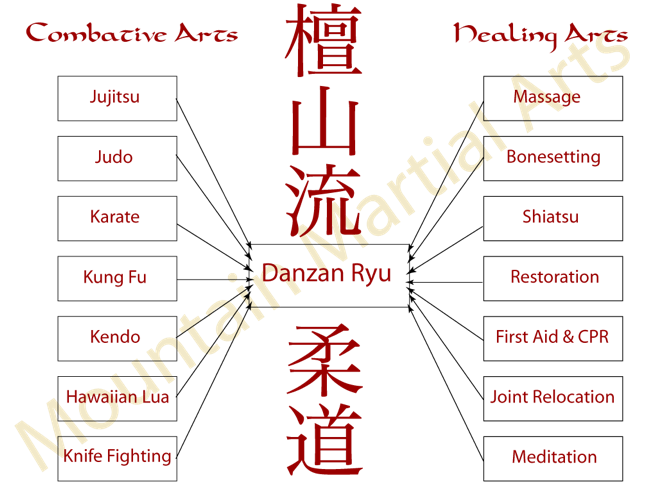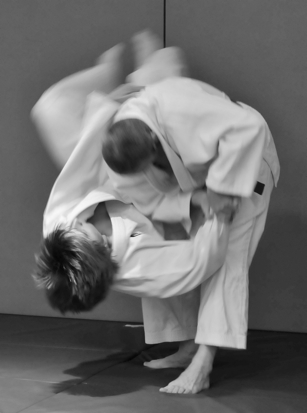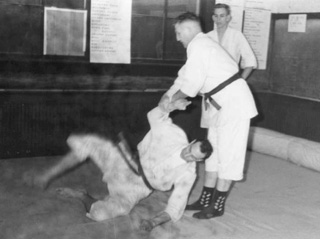Danzan Ryu Jujitsu is a combination of many different fighting styles and techniques as well as Asian healing methods. In additional to several styles of Jujitsu, Professor Okazaki mastered Karate, Judo, Filipino knife fighting, the Hawaiian art of Lua, Kung Fu, Savate (French foot fighting), and even American boxing and wrestling. In addition, Master Okazaki studied the healing arts of Kappo, Hawaiian Lomi Lomi Massage, and Seifukujitsu and came up with his own unique healing form known as the Okazaki Restoration Massage or Long Life Massage.
Below is a diagram of the many martial arts and skills that come together to form Danzan Ryu Jujitsu.

For those who may be new to martial arts, each of the systems listed on the left represents a unique style of fighting. Jujitsu is one of the oldest forms of martial art. It was the art of the samurai warrior and covers all aspects of combat. Judo is a modern sport derived from jujitsu and is identified with various throws, pins, and joint locks. Karate is often used in the west as a generic term for “martial arts”, however it is a specific Japanese art of punching, kicking, blocking, and striking. Kung Fu is Chinese and another of the oldest martial arts. This art uses a combination of punching, kicking, striking, takedowns, and weapons. Kendo is the Japanese art of the sword or literally translated as “way of the sword”. Lua is a very rarely known martial art safely guarded and taught to Hawaiian warriors charged with guarding the royal family. It is the art of life and death and was used against the enemies of some of the indigenous tribes. Filipino Knife Fighting is, as it sounds, the art of using a knife. This is taught in both defensive and offensive capacities in Danzan Ryu. The primary focus of Danzan Ryu is unarmed defense.
The right side of the diagram lists some of the many healing aspects of Danzan Ryu Jujitsu. These items are discussed briefly in the massage section, but have been included here to demonstrate the completeness of Okazaki’s art. All of these arts have been incorporated into Okazaki’s system in such a way that the student learns a little bit of each system at every rank. Further, it is done systematically so that the student is not inundated with the massive amount of knowledge contained within the system. See How We Teach to get an idea of what goes on in a typical class.
Physical Training
Danzan Ryu Jujitsu is taught in the tradition of senior students helping the junior students or Kodenkan. Students learn in small groups and progress at their own pace. The beginning student will learn basic warm up exercises, how to roll and fall safely, a list of hand techniques (Yawara), throwing and pinning techniques (Nage/Judo), the basic Okazaki massage and shiatsu, Striking/Blocking techniques and stances (Karate), concentration and breathing techniques, as well as basic CPR. All of this will begin at the white belt level and be built upon as the student progresses through the ranks of Shoden (beginning level). Intermediate instruction focuses on teaching and establishing leadership qualities. Senior students must not only master and teach the arts in turn before being taught the next, but keep a notebook in which they write up their own description of each art. The intermediate (Chuden) arts Include the basic control and constriction techniques (Shime), the deep forms (Oku), advanced hand techniques (Jokyu Yawara), weapons defense and offense techniques (Kiai no Maki), as well as variations on all previous arts and the addition of more advanced healing arts.


Mental Training
Danzan Ryu Students begin their mental training from day one. Methods in concentration and breathing are taught at the white belt level and continue through black belt. Students are taught to keep a relaxed mind without preconceived thoughts so that the student can react spontaneously and naturally while applying the esoteric principles of Jujitsu in any situation. Only with a still mind can the student be aware enough to find a non-violent solution to a given situation or discern whether physical response is necessary.
